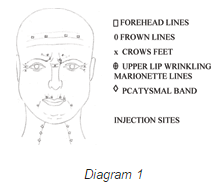Botox
Botulinumtoxin-Injektionen
Begutachtet von Dr. Colin Tidy, MRCGPZuletzt aktualisiert von Dr. Hayley Willacy, FRCGP Zuletzt aktualisiert am 19 Jul 2023
Erfüllt die Anforderungen des Patienten redaktionelle Richtlinien
- HerunterladenHerunterladen
- Teilen Sie
- Sprache
- Diskussion
In this series:Lip enhancement
Dieses Merkblatt wird von der British Association of Aesthetic Plastic Surgeons (Britischer Verband der Ästhetisch-Plastischen Chirurgen) zur Verfügung gestellt, dem Berufsverband, der für die Förderung der Ausbildung und Sicherheit in der Ästhetisch-Plastischen Chirurgie zuständig ist.
In diesem Artikel:
Botulinum toxin is commercially available as Botox® or Dysport®. However, these injections are commonly referred to as 'Botox' whichever product is actually used. This leaflet will therefore refer only to 'Botox'.
Lesen Sie unten weiter
What is Botox?
Botox® and Dysport® are the trade names for Botulinum toxin, produced by a bacterium called Clostridium botulinum. Several types of toxins have been identified, but type A, which is used commercially, is the most potent.
Botox was first used in 1978 to weaken overactive muscles in the eye, followed by other neurological conditions such as dystonia and hemifacial spasm with good effects and few little side effects. Botox was first used cosmetically in 1990, to reduce facial wrinkles arising from muscle contraction.
What are wrinkles?
Wrinkles are part of the ageing process. They can be attributed to sun damage, effects of gravity and muscle contraction resulting from facial expressions such as frowning and laughing.
Wrinkles due to the effects of gravity represent natural sagging of tissue with age and are generally only improved by surgical tightening procedures. Wrinkles caused by muscle contraction such as frown lines between the eyebrows, forehead lines and crow's feet, can be improved by Botox treatment.
The various wrinkles caused by facial muscle contraction are illustrated on diagram 1. Botox can also be used to treat excessive sweating of the armpits and palms of the hands.
Botox injections

Lesen Sie unten weiter
How does botox work?
Botox acts by blocking acetylcholine, a chemical that is responsible for transmitting electrical impulses that cause muscle contractions. This results in muscle paralysis which is temporary, because new growth of nerves will re-innervate the muscles.
How long does botox take to work?
Botox usually takes effect 24-72 hours after injection, with maximum effect at about 1 to 2 weeks. Its effects generally last for approximately 3-4 months. When injected into the muscles that are responsible for expression wrinkles, it gives the face a more relaxed and smoother appearance.
Sometimes longer lasting effects (9-12 months) are seen after treatment of excessive sweating. When a gradual fading of treatment effect is noticed you may return to have another treatment.
What can you expect at the time of your procedure?
Botox is injected directly into the muscles that cause the wrinkles, using a very small needle. Several injections are usually needed at specific injection sites, depending on the area treated (see diagram 1). When used to treat excessive sweating in the armpits, Botox is injected directed into the axillary skin. Localised discomfort and bruises can occur, but no sedation or local anaesthesia is generally required. Normal activities can be resumed immediately.
Lesen Sie unten weiter
Was sind die Grenzen?
Whilst Botox can be very safe and effective way to reduce wrinkles due to muscle contractions, it has no effect in reducing the fine lines on the face caused by sun damage, and lines due to sagging of facial skin. In those patients with very heavy lines, repeated treatments may be needed for maximum effect.
Too frequent or excessive dosing of Botox may lead to a patient's resistance to treatment due to antibody formation. Botox treatment may also exaggerate any facial asymmetry and make the face look more lop-sided.
Who should not have botox?
The use of Botox is not recommended for:
People with neuromuscular disorders such as myasthenia gravis.
Those who are taking certain medications; muscle relaxants, antibiotics such as aminoglycosides (eg, gentamicin).
Pregnant or breastfeeding women.
Those with infection or inflammation at the proposed site of injections.
People who have bleeding disorders.
Is botox safe?
No severe complications after cosmetic use of Botox have been reported in the literature. Very rarely excessive weakening of the target muscles and paresis of adjacent muscles can occur, resulting in facial weakness. This is self-limiting. When injecting above the eyebrows, upper eyelid ptosis or slight drooping may occur but only 1:100. This can be corrected with eyedrops but will also improve as the effects of the Botox wear off.
Content used with permission from the British Association of Aesthetic Plastic Surgeons website: Botulinum toxin injections. Copyright for this leaflet is with the BAAPS.
Haftungsausschluss
Dieses Merkblatt soll nützliche Informationen liefern, ist aber nicht als Ratschlag für einen bestimmten Fall zu verstehen. Sie ersetzt nicht die Notwendigkeit einer gründlichen Beratung, und alle potenziellen Patienten sollten den Rat eines entsprechend qualifizierten Arztes einholen. Die BAAPS übernimmt keine Haftung für Entscheidungen, die der Leser in Bezug auf die von ihm gewählte Behandlung trifft.
Leaflet originally written by British Association of Aesthetic Plastic Surgeons.
Patient picks for Cosmetic surgery

Chirurgie und Verfahren
Brustverkleinerung
Dieses Merkblatt wird von der British Association of Aesthetic Plastic Surgeons (Britischer Verband der Ästhetisch-Plastischen Chirurgen) zur Verfügung gestellt, dem Berufsverband, der für die Förderung der Ausbildung und Sicherheit in der Ästhetisch-Plastischen Chirurgie zuständig ist.
von der britischen Vereinigung der plastischen Chirurgen (BAAPS)

Chirurgie und Verfahren
Bruststraffung
Dieses Merkblatt wird von der British Association of Aesthetic Plastic Surgeons (Britischer Verband der Ästhetisch-Plastischen Chirurgen) zur Verfügung gestellt, dem Berufsverband, der für die Förderung der Ausbildung und Sicherheit in der Ästhetisch-Plastischen Chirurgie zuständig ist.
von der britischen Vereinigung der plastischen Chirurgen (BAAPS)
Weiterführende Literatur und Referenzen
- Manufacturer's PIL, Botox® 50, 100 and 200 Allergan Units; AbbVie Ltd, The electronic Medicines Compendium. Dated April 2023.
- Borba A, Matayoshi S, Rodrigues M; Avoiding Complications on the Upper Face Treatment With Botulinum Toxin: A Practical Guide. Aesthetic Plast Surg. 2022 Feb;46(1):385-394. doi: 10.1007/s00266-021-02483-1. Epub 2021 Aug 2.
- Sundaram H, Signorini M, Liew S, et al; Global Aesthetics Consensus: Botulinum Toxin Type A--Evidence-Based Review, Emerging Concepts, and Consensus Recommendations for Aesthetic Use, Including Updates on Complications. Plast Reconstr Surg. 2016 Mar;137(3):518e-529e. doi: 10.1097/01.prs.0000475758.63709.23.
Lesen Sie unten weiter
Artikel Geschichte
Die Informationen auf dieser Seite wurden von qualifizierten Klinikern verfasst und von Fachleuten geprüft.
Nächste Überprüfung fällig: 17. Juli 2028
19 Jul 2023 | Neueste Version

Fragen, teilen, verbinden.
Stöbern Sie in Diskussionen, stellen Sie Fragen, und tauschen Sie Erfahrungen zu Hunderten von Gesundheitsthemen aus.

Fühlen Sie sich unwohl?
Beurteilen Sie Ihre Symptome online und kostenlos
Sign up to the Patient newsletter
Your weekly dose of clear, trustworthy health advice - written to help you feel informed, confident and in control.
By subscribing you accept our Privacy Policy. You can unsubscribe at any time. We never sell your data.